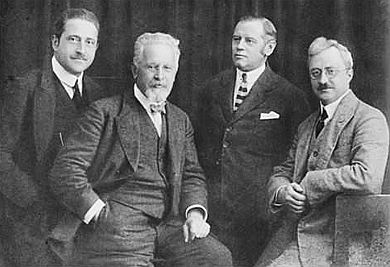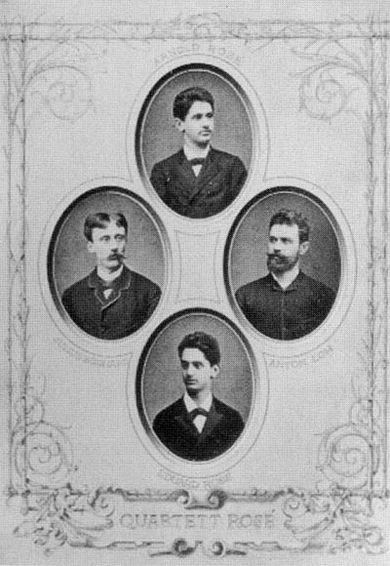Rosé Quartet facts for kids

The Rosé Quartet was a very famous string quartet. This means it was a group of four musicians who played string instruments like violins, violas, and cellos. The quartet was started by a talented musician named Arnold Rosé in 1882.
This musical group was active for a long time, playing for 55 years until 1938. They were known for their amazing performances and for helping new music become popular.
Meet the Musicians
The musicians in the Rosé Quartet changed over the years.
- First Violin: Arnold Rosé was always the first violinist. He was the leader of the group.
- Second Violin: At first, Julius Egghard Jr. played the second violin. Later, Albert Bachrich took over. From 1905, Paul Fischer joined the group.
- Viola: The first violist was Anton Loh. Then, Hugo von Steiner played until 1901. After that, Anton Ruzitska joined. From 1920, Max Handl played the viola.
- Cello: Eduard Rosé, Arnold's brother, was a founding member and played the cello. He left after one season. Reinhold Hummer then played the cello, followed by Friedrich Buxbaum. In 1921, Anton Walter joined. Later, Buxbaum returned to the group.
The quartet was at its best between 1905 and 1920. During this time, the main members were Arnold Rosé, Paul Fischer, Anton Ruzitska, and Friedrich Buxbaum.
What They Played
The quartet's repertoire (the list of musical pieces they performed) mainly included works by famous composers. These composers were Haydn, Mozart, and Beethoven.
However, the Rosé Quartet also supported many composers of their own time. They helped new music become known. One important modern composer they supported was Arnold Schoenberg.
Special Performances
The Rosé Quartet was often the first to play new pieces of music in Vienna, Austria. This is called a premiere.
- They performed the Vienna premieres of works by Brahms. This included his Clarinet Quintet.
- They also premiered Arnold Schoenberg's first and second string quartets.
- The quartet helped premiere Schoenberg's piece called Verklärte Nacht. For this performance, two extra musicians from the Vienna Philharmonic Orchestra joined them.
The Rosé Quartet also worked with other famous musicians. These included Julius Röntgen, Johannes Brahms, Franz Steiner, Bruno Walter, and Richard Mühlfeld. The quartet also made recordings of their music.


